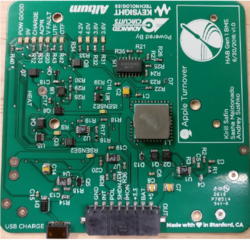Difference between revisions of "Balloons Gen 3 BMS"
Jump to navigation
Jump to search
(Created page with "'''Cupcake''' is the 3rd iteration of the '''B'''attery '''M'''anagement '''S'''system for the HABEES Standard Avionics Platform. It addresses the complexity issue of the prev...") |
|||
| Line 1: | Line 1: | ||
| + | {{HABEES-sidebar | ||
| + | | header = Cupcake | ||
| + | | img link = File:appleturnover.png | ||
| + | | designer = Zachary Belateche | ||
| + | | techline = Balloons Core Power | ||
| + | | version = Generation III | ||
| + | | name = Cupcake | ||
| + | }} | ||
| + | |||
| + | [[Category: High Altitude Balloons]][[Category: HABEES]] | ||
| + | |||
'''Cupcake''' is the 3rd iteration of the '''B'''attery '''M'''anagement '''S'''system for the HABEES Standard Avionics Platform. It addresses the complexity issue of the previous generation by removing the data collection circuitry/microcontroller, and adding a separate power path for expansion boards. It is compliant with the Gen 2 Architecture.<br/> | '''Cupcake''' is the 3rd iteration of the '''B'''attery '''M'''anagement '''S'''system for the HABEES Standard Avionics Platform. It addresses the complexity issue of the previous generation by removing the data collection circuitry/microcontroller, and adding a separate power path for expansion boards. It is compliant with the Gen 2 Architecture.<br/> | ||
Revision as of 04:50, 15 July 2018
| Cupcake | |
|---|---|
| Part of the HABEES series | |

| |
| Chief Designer | Zachary Belateche |
| Technology Line | Balloons Core Power |
| Version | Generation III |
| Name | Cupcake |
| General | |
| HONEY Standards • Venom Breakout • Fang Breakout • Board Naming | |
| Core Architecture | |
| Gen 1 Architecture • HONEY | |
| Core Avionics | |
| Oscar • Cookie Monster • Elmo • The Count | |
| Core Power | |
| Apple Turnover• Biscuit | |
| Core Peripherals | |
| Medusa • Cobra • Viper • QueenBee • ProtoBee | |
| Core Radio | |
| Macaw | |
| Test & Prototype | |
| QueenBee | |
| Guides | |
| Making a HONEY Board • Using STINGR • Using QueenBee • Making a Prototype | |
| V • E | |
Cupcake is the 3rd iteration of the Battery Management Ssystem for the HABEES Standard Avionics Platform. It addresses the complexity issue of the previous generation by removing the data collection circuitry/microcontroller, and adding a separate power path for expansion boards. It is compliant with the Gen 2 Architecture.
Outputs:
- Main Avionics Power Path
- 3.3V, 5V
- Expansion Board Power Path
- 1.8V, 3.3V, 5V
- Shared raw cell voltage (VBAT)
Features of each power path:
- Voltage and Current Protector (Undervoltage 3V, Overvoltage 5V, Overcurrent 5A)
- Buckboost for 5V and LDO (low dropout regulator) for 3.3V
Additional features:
- Temperature Monitor (Overtemp 50C, Heater activated at -10C)
- inboard heater
- Status LEDs for charging indicator and faults